“The Golden Age of universities enjoyed in the developed world since the mid-twentieth century is passing. Good times are giving way to tough times. Success will be harder to come by.” (Parker, 2020)
The growth of higher education since the end of Second World War have been extraordinary. Starting out as an elite system to a mass-participation system in most countries throughout the world. The participation rate have grew by a factor of 6.12 between 1970 and 2013 (Marginson, 2017). The ‘human capitol theory’ giving justification to investment in higher education for economic growth was popular in the era. It was also a generation empowered by the social idea of ‘equality of opportunity’ for everyone and the growing middle-classes abroad, have begun investing in foreign education (mainly US, UK, Australia, and Canada). As for the cherry on top, expansion of technological and medical advancements only possible through extensive researches conducted in an academic environment; these combinations of factors brough about the ‘Golden Age of higher educations’.
However, the curtain is closing for that period as different elements are coming together.
The rising tuition fees of the universities due to inefficiency of their structures, attainment rates of bachelor degree reaching as high as 50% of the population in some countries, tapped with fundamental economic problems and rise of competition, and the complaints of corporations towards university graduates not meeting the needs of the industry have come tumbling down on the current universities. In the UK, research estimates that one-fifth of degrees are not worth the money compared with their future-earnings; that those who did not go to university are better off than those who graduated (Britton, 2020). In the US, the student debt that was tripled between 2001 and 2016 went against the idea of ‘equality of opportunity’ that they advocated; leaving most of the graduates as slaves of tuition debt, not making them able to advance in society.
Also, another large factor have come into play. The fourth industrial revolution, a fusion of advances in artificial intelligence (AI), robotics, and the Internet of Things (IoT), quantum computing and other technologies, is driving the change in education stronger than their preceding steam, electricity, and computing revolutions (McGinnis, 2020). The universities that persevered through different revolutions by optimizing to the needs of that time must come to realize that they also must go through a revolution, and that they are not immune from the coming change that will take place.
Classrooms that prioritized face-to-face learning must find new mediums to deliver their lectures. Many universities have and will deliberately promote a physical experience on campus as part of their value proposition, but they will become a minority. Finding a balance in blended learning experience and online education through offline facilitation with virtual learning environment will be the new demand for the digitally cultured generations, as well as a need for technologically advanced industry that must take on their graduates.

Finally, the idea of consumer sovereignty, to provide products and experiences focused on their consumers have become more dominant through rise of social, online purchasing, abundant product information, and the ability to switch preferences quickly, have given a name to this era as the ‘Age of Customer’ (Parker, 2020).
No business can ignore the customer experience anymore in this ‘age of Customer’. It is still early days, but many institutions and rising companies are probing to solve the problem of ‘personalized education’ at large scale monitored by arrays of analytics. The choice of learnings are becoming more open through modular courses and degrees; students do not have to put everything else in their life on hold to have immersive experience in offline campuses anymore; they can take part-time study while completing their credentials not only periodically, but through life-long learning. The true ‘age of customer’ is coming even to the universities and education.
The Covid-19 pandemic have educated to the mass public, that shift to online and blended learning solutions are possible. But the needs for the educational revolutions in universities have been in demand for decades. Universities may need to catch up on their homework on optimizing and transforming their services; or take the risk of not changing, and maintaining their current “status quo”. But the competitions are rising from places unexpected, from companies and platforms that plans to take the new era of education.
